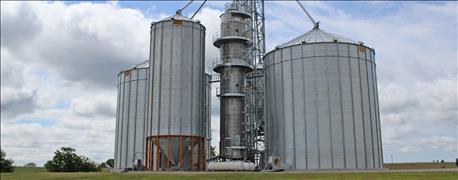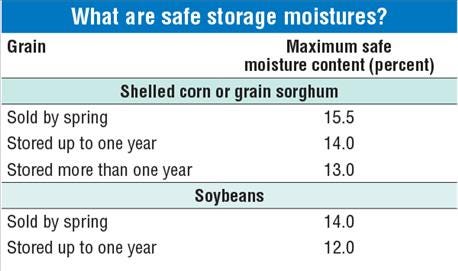
Farmers are storing grain this year in hopes of seeing higher commodity prices. It is important that they protect the grain, and that means extra management this winter to keep the grain in the bin in good condition.

MONITORING GRAIN: In order to take advantage of any commodity price uptick, farmers need to keep grain stored on the farm in good condition. It will take a little extra management this winter.
Air temperature outside and inside the bin can create problems. According to Kent Shannon, University of Missouri natural resource engineering specialist, because of differences in temperature between the grain in the bin and the outside air, air inside the bin migrates. "With cold outside air, the air inside the bin moves downward along the outside wall and then upward toward the center of the bin," he wrote in a recent Ag Connection newsletter. "The air that comes up through the center of the bin will carry some moisture as it contacts the cool grain in the center of the bin. Moisture will then condense and cause the grain in this area to go out of condition and crust over."
Crusting keeps air from flowing through the mass of grain and makes it impossible to keep the grain in condition, he warns. To prevent this problem, Shannon says, grain should be cooled to about 40 degrees F in the fall and warmed to about 60 degrees F in the spring. This will minimize migration of air through the bin.
Shannon offers four tips to keep stored grain in condition during the winter months:

1. Check grain weekly. Use a grain probe and a thermometer to check the temperature by probing below the surface of the grain in several places. Record these temperatures to monitor changes. Moving air through the grain can help in determining grain condition. If a musty odor is detected, problems may exist that weren't detected by inspecting the grain or checking the temperature. If problems do occur, fans may need to be run to dry the grain. In some cases, grain may need to be removed from the bin.
2. Protect from pests. Covering the fan intake when it is not in use can prevent air from moving through it, and minimize insect and rodent problems.
3. Regulate air movement. Farmers often ask Shannon, "Should air be pushed or pulled through the bin?" He says there is no right or wrong answer.
If air is pushed through the grain, moisture is most likely to condense on the cold roof. This can cause some moisture problems with grain at the top of the bin. An advantage of pushing the air is that if grain spoilage does occur, it will most likely be at the top of the bin and is easier to detect.
When air is pulled through the bin, the moist air coming off the grain can condense on the floor and on grain near the floor. This can block ducts and plug the aeration system. If air is pulled through the grain, one should wait until several feet of grain have been placed in the bin to avoid pulling fines into the duct.
4. Run the fan. Shannon says farmers need to make sure they leave the fan on long enough. Any time a drying or cooling front is started through the grain, make sure the fan runs long enough to move the front completely through the grain. When the temperature of the air coming through the grain is equal to the outside air, drying or cooling is complete.
About the Author(s)
You May Also Like






